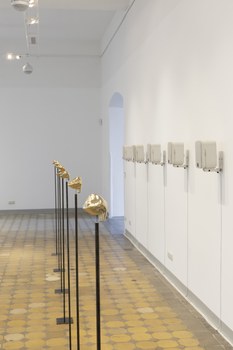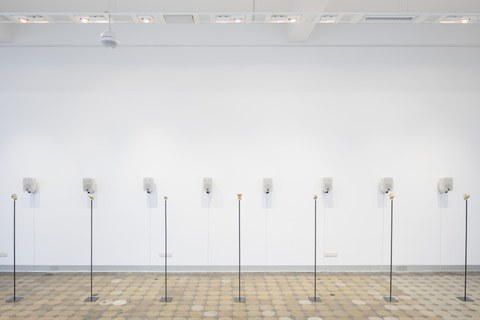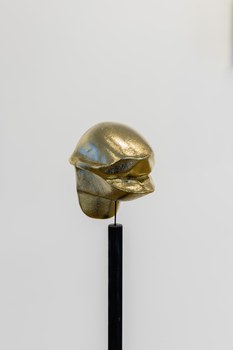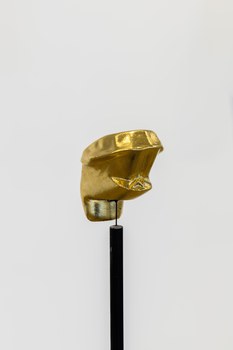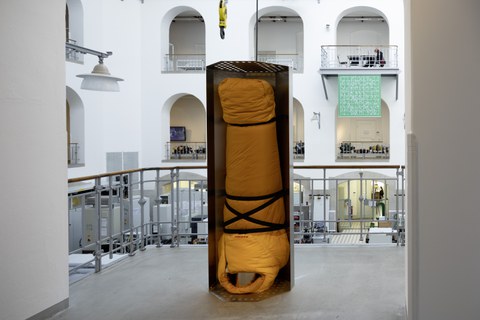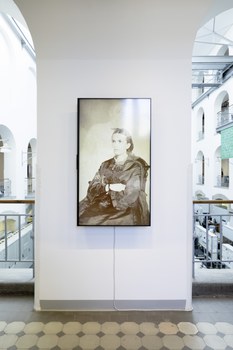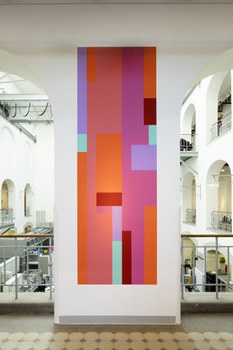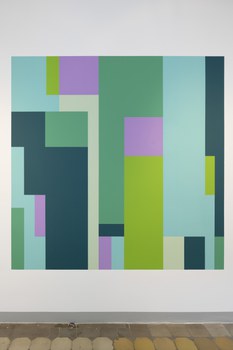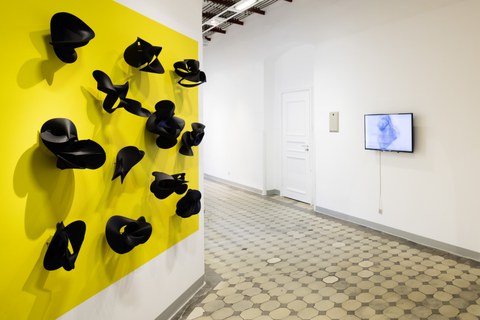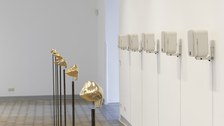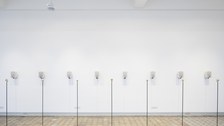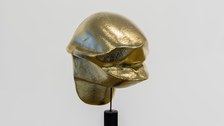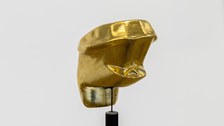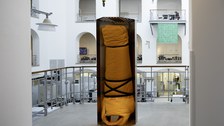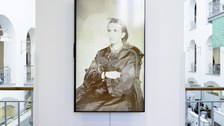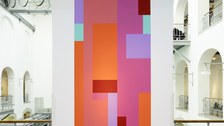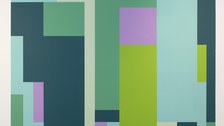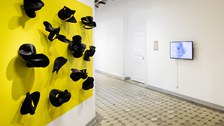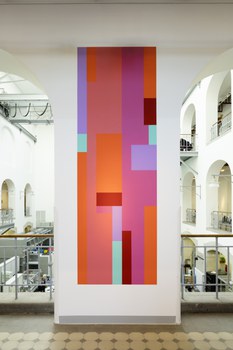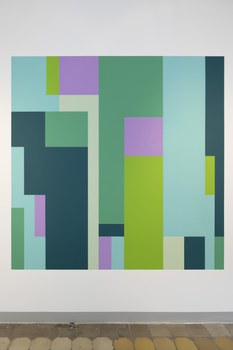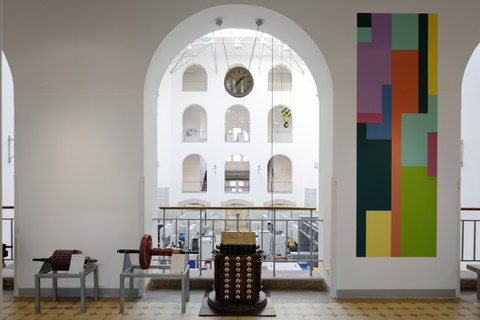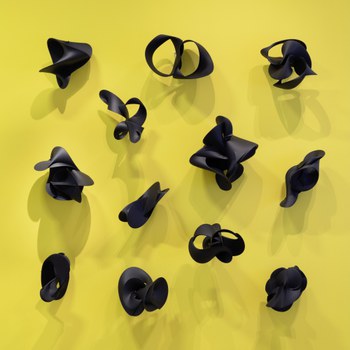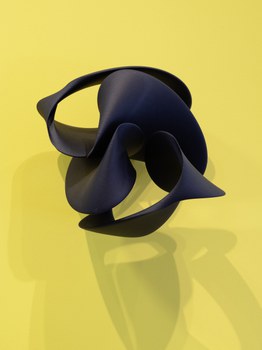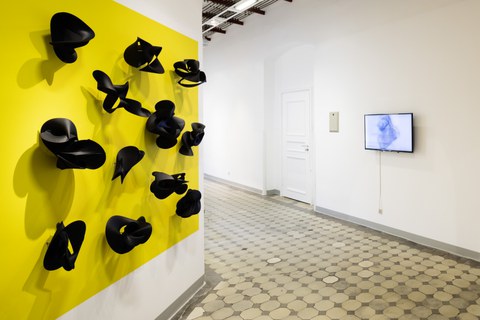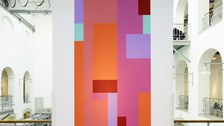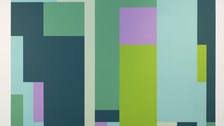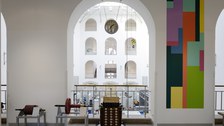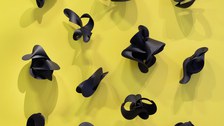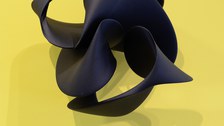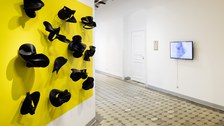A & I. Joint presentation of Christian Kosmas Mayer and Anton Ginzburg, Artists in Residence 2020 and 2021
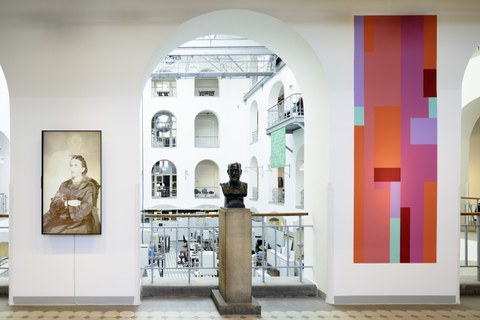
Ausstellungsansicht A & I in der Altana Galerie der Kustodie der TU Dresden, links: Videoarbeit von Christian Kosmas Mayer, rechts: Mural von Anton Ginzburg / Installation view of the exhibition A & I at the Altana Galerie of the Office for Academic Herit
The joint exhibition on the residencies 2020 and 2021 in the Gallery of the Office for Academic Heritage, Scientific and Art Collections of TU Dresden
12 Nov 2021 - 11 March 2022
Views into the exhibition
The dual exhibition "A & I " presents the resulting projects of the program’s first two artists-in-residence: Christian Kosmas Mayer (b. 1976 in Sigmaringen, lives and works in Vienna) and Anton Ginzburg (b. 1974 in St. Petersburg, lives and works in New York), who each spent time at the TU in 2020/21.
Coordinated by TU’s Office for Academic Heritage, the Schaufler Residency@TU Dresden is an artist-in-residence program that aims to advance creative research among artists. The ensuing projects are process-based and must focus on collaborative practice between art and science.
Both Christian Kosmas Mayer and Anton Ginzburg have worked with and on artificial intelligence, each approaching it from very different angles. In their respective artistic pursuits they reached out to and energized scientists with very different specialisms within the TU’s research community.
Christian Kosmas Mayer, Schaufler Residency@TU Dresden 2020
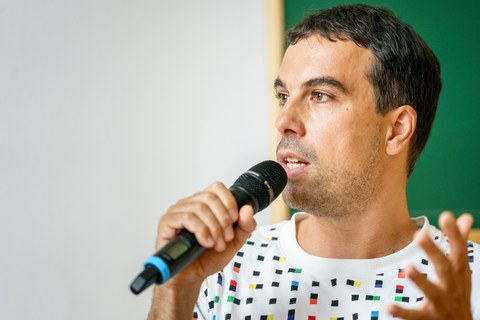
16.9.2020: Open Studio@Schaufler Lab "Konservierung und Archivierung: Zwischen Natur, Technik, Kunst und Künstlicher Intelligenz": Christian Kosmas Mayer, Schaufler Residency@TU Dresden 2020
Drawing on earlier works of his, Christian Kosmas Mayer explored cultural-historical concepts of immortality against the backdrop of the present day and the radical advances currently sweeping across the fields of biotechnology and artificial intelligence (AI).
In his research practice, the human voice plays a pivotal role as a primordial medium of expression, of vital importance in ideas relating to the afterlife, be it in ancient Egypt or the present day. Because we live in an age when AI enables us to synthesize the voices of those long-dead and thus revive them in digital form, their voices are able to float free of their bodies, living on through technology in an afterlife that is potentially never-ending. By partnering with the Chair of Speech Technology and Cognitive Systems at the TU’s Institute of Acoustics and Speech Communication, Mayer has now used the latest speech-synthesis technology to produce sounds based on the vocal tract of a specific human being who lived 2000 years ago. From these sounds, he has composed a moving and enigmatic multi-channel sound piece that combines the archaic with the hypermodern and upends our conventional notions of age and the passing of time.
The disembodied and lingering presence of the voice finds its materialized and ossified echo in the sculpture series the Golden Tongues. Models of human tongues from the late 19th century preserved in the Historical Acoustic-Phonetic Collection at the TU Dresden were the source for replicas that were transformed into extremely durable metal objects. The technique of gilding has been used since antiquity to lend objects a timeless finish, giving them the chance to escape the finite time scale of each passing human civilization.
Mayer is especially drawn to such phenomena and objects, which, even in death, know no rest and drift through time, resurfacing at various points in history in different contexts and charged with different meaning. This is also evident in his AI-generated animations of vintage photographs dating from the mid-19th century, when photography itself was still considered a magical medium by many. The late sci-fi author and physicist Arthur C. Clarke (1917–2008) once claimed that “any sufficiently advanced technology is indistinguishable from magic”. If that be true, then the latest advances in biotechnology and AI will one day have previously unimagined ways to seduce us into interpreting the ghostly phenomena of autonomous algorithmic computations as works of magic.
As a commentary on the current discourse surrounding AI applications in biotechnology, Christian Kosmas Mayer’s poetic, sensual, and at-once imaginatively speculative approach presents a glimpse of this future. And rather than examining it as separate to Humanism and traditional knowledge systems, Mayer shows how such a future is actually rooted in and predetermined by them.
Anton Ginzburg, Schaufler Residency@TU Dresden 2021
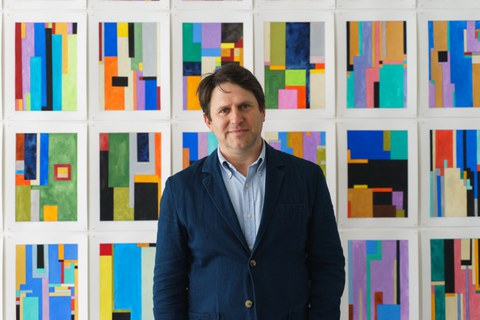
Anton Ginzburg, Schaufler Residency@TU Dresden 2021, vor den Gouachen seiner "Dresden Series"
In his genre-spanning work, Anton Ginzburg explores art-historical and cultural references. At the core of his practice are the artistic study and adaptation of the visual vocabulary of 20th-century Modernism, in both the Soviet and Western sphere, which he transfers to film, painting, and sculpture, revitalizing the Modernist vocabulary in the process.
Ginzburg spent much of his residency investigating construction-related art in the GDR, especially the system of molded concrete blocks which the Dresden artists Karl-Heinz Adler (1927–2018) and Friedrich Kracht (1925–2007) developed in the late 1960s for state-commissioned designs in urban spaces. Based on these abstractions and their visual translation into virtual space, Ginzburg created an algorithm-inspired series of gouaches (Dresden Series; 2021) and site-specific murals for the university’s gallery.
In another project he partnered with the Chair of Computer Graphics and Visualization to create computer-assisted visuals for a video work that straddles the line between action movie, public art, and car-crash scenario, and which is staged as an absurdly comic parable on contemporary art and society.
Meanwhile, by working with the Chair of Scientific Computing at the Faculty of Mathematics, Ginzburg explored how mathematics and algorithms can be used to transform the emotions displayed and conveyed in iconic movies, here remodeled as 3D objects and generated as artifacts at the interface of video art, object cultures, and visionary design. The basis for the visualizations were patterns and structures that the artist encountered while sifting through the many teaching collections of the TU’s Office for Academic Heritage, such as the Collection of Mathematical Models and the Color Research & Theory Collection.
Ginzburg’s preoccupation with AI primarily serves as the motor of his artistic practice, whereby he presents AI as an overarching social narrative oscillating between technological utopianism and its disruption. His works are thus animated by the spirit of machine participation, which is also increasingly permeating and altering the processes and mechanisms of the public sphere.
Further Information
Venue
Altana Galerie der Kustodie im Görges-Bau
Helmholtzstraße 9
01069 Dresden
Opening hours: Mon-Fri 10 am - 6 pm
Closing time: 23 Dec - 2 Jan
Admission: free
Publications
A publication on each of the two artists will be published by Sandstein Verlag. The catalogs will be available by June 2022 both in the Office for Academic Heritage of TU Dresden and in bookstores.

